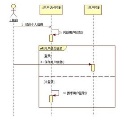Do patterns of eye-hand coordination observed during real-world object interactions apply to digital, screen-based object interactions? We adapted a real-world object interaction task (physically transferring cups in sequence about a tabletop) into a two-dimensional screen-based task (dragging-and-dropping circles in sequence with a cursor). We collected gaze (with webcam eye-tracking) and cursor position data from 51 fully-remote, crowd-sourced participants who performed the task on their own computer. We applied real-world time-series data segmentation strategies to resolve the self-paced movement sequence into phases of object interaction and rigorously cleaned the webcam eye-tracking data. In this preliminary investigation, we found that: 1) real-world eye-hand coordination patterns persist and adapt in this digital context, and 2) remote, online, cursor-tracking and webcam eye-tracking are useful tools for capturing visuomotor behaviours during this ecologically-valid human-computer interaction task. We discuss how these findings might inform design principles and further investigations into natural behaviours that persist in digital environments.
翻译:现实世界中的眼-手协调模式能否适用于数字屏幕上的对象交互?我们将一项现实世界的对象交互任务(在桌面上按顺序传递杯子)改编为二维屏幕上的任务(使用光标依次拖放圆形)。我们从51位完全远程的众包参与者收集了眼神(使用网络摄像头进行跟踪)和光标位置数据,他们在自己的计算机上完成了该任务。我们应用了现实时间序列数据分割策略,将自主移动序列解析为对象交互的阶段,并对网络摄像头的眼球追踪数据进行了严格的清理。在这项初步调查中,我们发现:1)现实世界的眼-手协调模式在这个数字上下文中保持和适应,2)远程、在线的光标跟踪和网络摄像头眼球跟踪是捕捉此生态有效的人机交互任务中的视觉运动行为的有用工具。我们讨论了这些发现如何指导设计原则,以及进一步调查在数字环境中保留的自然行为。


